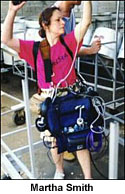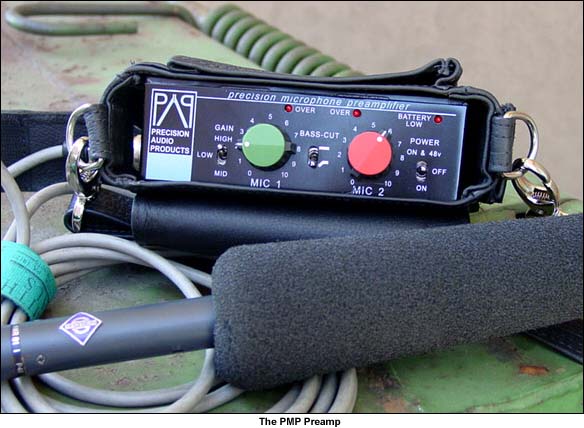Camera
Corner
PMP
Preamp Review
by
Martha Smith
|

|
Precision Audio
Products' microphone preamplifier is a small unit, measuring about 41/2"
by 51/2" by 2". Facing the operator are two potentiometer
knobs, controlling volume for channels one and two, a gain switch (low,
mid and high), a bass cut switch (flat and roll off), and a power switch,
which has a provision for 48v phantom power (very convenient). Each
"pot" is large (green for channel 1; red for channel 2) and
easy to turn; each channel has an LED that flashes red when the "pot"
needs to be turned down. There is a low battery warning light, which
comes on when the batteries reach 6.5v On the left side of the unit
are two XLR balanced microphone inputs; on the right side, there are
two XLR line outputs. The unit is powered by two 9v batteries, housed
in a compartment on the bottom. For carrying, there is a swell leather
pouch (with shoulder strap), which has velcroed flaps on each side for
access to the XLR connectors, and one on the bottom for access to the
batteries. List price is $330.00, including leather carrying case.

You
look at the "PMP" (for precision microphone preamplifier),
and think, "Ah, a small mixer". But it's not. The
PMP amplifies two microphone signals coming in, to two line-level signals
going out. Carlos Martinez of Precision Audio Products has a refreshing
point of view. He says the PMP was deliberately designed to be simple
for use by "amateurs" (I prefer "novices"), who
use mics with DAT machines, MD units or miniDV cameras. These small,
portable, audio recording devices typically have preamps which are "not
very good" says Carlos; hence the need for a preamp, like the PMP.
Line-level "out" from the PMP to line-level "in"
in any of these devices minimizes problems like AGC circuit "pumping"
and "noise". The PMP is not designed to be a mixer, he says,
because mixing is best left for post production. (Sound advice - no
pun intended.) There is no headphone output on the PMP, because the
designers advocate that headset monitoring should be done at the end
of the line. (Sensible, but perhaps unrealistic). The PMP is deliberately
designed to make the unit simple to operate, and to give users few options
in the field, so as to minimize the occurrence of "accidents"
(such as mixing out-of-phase cables).
When I think about my location work with a mixer, I realize that I mix
infrequently. For good reason - it takes a lot of concentration to mix
"live"; mistakes are bound to occur when you mix unscripted
sources in real time. Much better to record two clean tracks in the
field, and leave the mixing for the edit suite.
In the field, I use my mixer primarily as a multi-input device, with
multiple mics "standing by", ready to be used, as needed,
to feed two channels "out". I recently recorded audio at a
Middle School graduation. I had four mic inputs--a wireless feed from
a board mixing "house" mics, a wireless lav on the Principal,
a wireless lav on the Governor who was paying a visit, and a shotgun.
Although I had multiple mics "standing by"all of the time,
I mixed them only occasionally. For instance, when the Guv plunged into
the crowd to shake hands, I used his mic alone on Channel 1, and used
the shotgun alone on Channel 2 for crowd reaction. But when I noticed
the Governor and the Principal having a side chat while the graduates
marched into hall, I decided to mix their mics (on Channel 1), and leave
the house feed running on Channel 2. Since the house mics didn't pick
up the piano playing that Graduation March we all know so well, I mic'ed
the piano with the shotgun and mixed it into the house feed. So, at
the moment the Governor and the Principal were having their side chat,
I was using all four mic inputs split between two channels of output.
Mixing four inputs in real time, to provide audio that an editor can
work with effectively in post production, is not difficult. But it does
require the full concentration of a dedicated audio recordist. A "one-man-band"
recording with a miniDV camera isn't able to give this kind of attention
to on-location sound recording.
This is a long-winded way of getting around to urging you to think about
how you use mics in the field. Do you typically use two separate mics
for two separate channels? More? Less? Do you need a mixer? Do you need
a cleaner signal/noise ratio? Are you happy if you simply get sound
at all?
I can't imagine that most of you wish to mix in the field. I can more
easily imagine that some of you would like to use a preamplifier like
the PMP to insure a higher quality mic signal. There are some things
I really like about the PMP; there are some things I worry about.
I worry about the connections between the PMP and a miniDV camera. First
of all, because the PMP is not designed to be attached to the camera,
there will be dangling connecting cables. In any situation where you
move around (even with the camera and PMP over your shoulder), dangling
cables are prone to snag and yank, which can break a cable, ruin a shot,
or both. Second, the PMP sends a line-level signal "out".
Not all miniDV cameras are designed to take a line-level signal "in".
Some will record line level, but only through that weird A/V plug. (I'm
sure it's a perfectly good plug, but, like Carlos Martinez, I'm wary
of 1/8" plugs.)
I worry about the lack of headset monitoring. While I admire the designers'
attempt to save us from the temptation of not monitoring at the camera
end, I'm not happy that they've ignored the need to monitor mics coming
into the PMP during set-up. The only sensible way to set up your audio
recording system quickly and
efficiently is to check mics first at the PMP, and then move your headsets
to the camera for a final audio check prior to tape roll. And (God forbid!),
if there's an audio problem, you absolutely-positively need to be able
to check that mics coming into the PMP are ok, before you move on to
listen to the camera connections. What I worry about most, though, is
having only one point of audio monitoring on location. To me, the only
way to
ensure success in any location recording (audio or video) is to build
in redundancies. The PMP needs to be your redundant headset monitoring
point on location. I was glad to read an E-mail from Carlos Martinez
stating that there is a plan is to add a headset monitor soon. I fear,
given Carlos' understandable dislike of 1/8" plugs, that it will
have only a 1/4" plug. I urge the designers to include an 1/8"
monitor plug as well, as that will allow people who intend to monitor
audio at the camera end, to use their 1/8"-wired headsets for both.
The Precision Audio Products' literature claims that the PMP will run
12 hours continuously on two 9v batteries. I have no reason to doubt
that. For test purposes, I used two less-than 9v batteries recycled
from my wireless system (just as I do when I power my mixer). I discovered
that both batteries are needed to power the unit. I switched the power
from "on" to "on and 48v" and added my short shotgun.
The PMP powered it continuously for three hours before the low battery
LED came on - more than enough continuous operation time in my line
of work. I was very pleasantly surprised to discover that there was
no degradation in the mic signal due to a low battery. Carlos Martinez
gave me a useful tip for this situation. Since the 48v power is drawn
off only one 9v, you can flip the batteries once they reach a "low
battery" stage to gain a little extra 48v-powering time out of
them.
I was puzzled by the "gain" switch (high, low, mid) at first.
Carlos told me that it is intended to set the gain on the input of the
low noise chip. Different types of mics need different settings. The
goal is to choose a "gain" position which allows good volume
output with the "pot" set at "4-6". "High"
should be used for dynamic mics like the 635. I found that "Mid"
worked best for the other mics I tried out--Neumann and Sennheiser short
shotguns, a Lectrosonics wireless system.
Until Dirck sent me the PMP to test out, I had never thought about using
a microphone preamplifier in the field to obtain high-quality audio
signals. I wouldn't use one on an assignment to record the Governor
at a Middle School graduation. But, I can imagine the PMP being used
to get high-quality mic signals into the XL1 while shooting a low-budget
feature. Or, I can imagine the PMP powering and amplifying two Neumann
mics standing left and right in a concert hall, sending audio to an
XL1. I can't imagine it being used by "amateurs', which is why
I believe the well-intentioned design decision to keep the unit's operation
simple, backfired. A "pro" or "semi-pro" needs greater
versatility, like the ability to assign "gain" and phantom
power separately, on each channel.
I corresponded with Carlos Martinez via E-mail, and went to Precision
Audio Products' web site - www.preciseaudio.com.
It is clear to me that Carlos is very nice person, and a very knowledgeable
designer. Go to the web site for more information about the PMP. And
check out the FAQ - there's good information for every audio recordist,
no matter what your level of expertise.
© 2002 Martha Smith
http://www.videosmith.com
|

